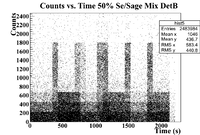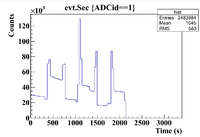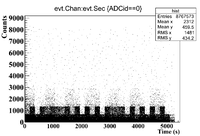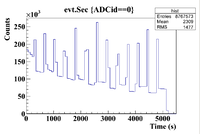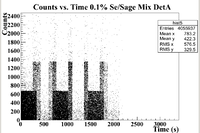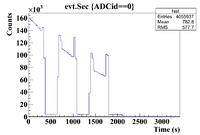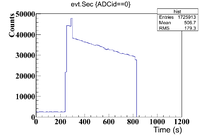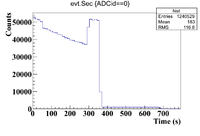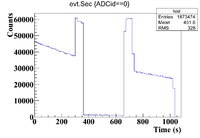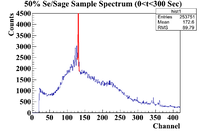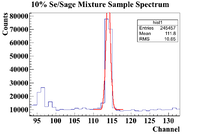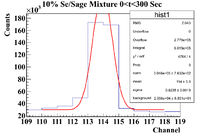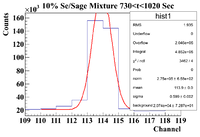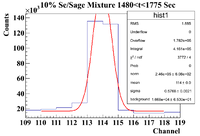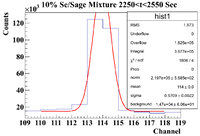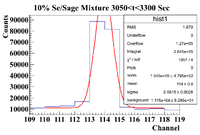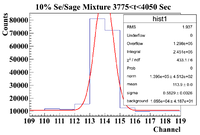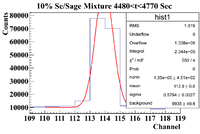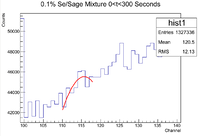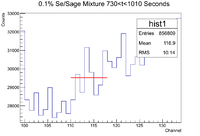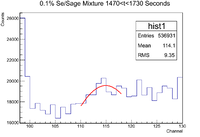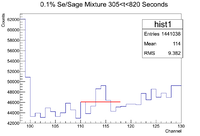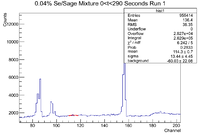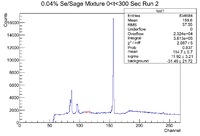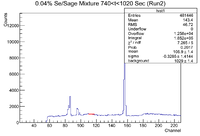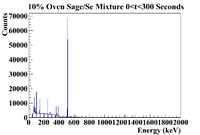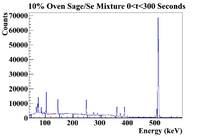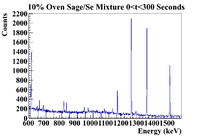Difference between revisions of "LB SageBrushWork PostDefense"
| Line 407: | Line 407: | ||
==144.5 keV Line== | ==144.5 keV Line== | ||
| − | Note: the x-axis for the first 2 histograms should be Energy (keV) | + | Note: the x-axis for the first 2 histograms should be Energy (keV). This line is NOT present in the Pure Se Sample, so it should be a line produced by the sage itself. |
{| border="3" cellpadding="5" cellspacing="0" | {| border="3" cellpadding="5" cellspacing="0" | ||
Revision as of 18:18, 5 September 2018
Mass Information
The target masses are as follows
50% Se/Sage Sample
| Selenium Target (50% Sagebrush Se Mix) | Mass (g) |
| Outer Front Ni Foil | 0.6948 |
| Se Mass | 0.51 |
| Outer Se Mass | 0.1 |
| Sagebrush Leaves Mass | 0.4969 |
10% Sample
| Selenium Target (10% Sagebrush Se Mix) | Mass (g) |
| Outer Front Ni Foil | 0.2783 |
| Se Mass | 0.0523 |
| Outer Se Mass | 0.0971 |
| Sagebrush Leaves Mass | 0.5111 |
0.1% Se/Sage Sample
| Selenium Target (0.1% Sagebrush Se Mix) | Mass (g) |
| Outer Front Ni Foil | 1.1437 |
| Se Mass | 0.0559 |
| Outer Se Mass | 0.1118 |
| Sagebrush Leaves Mass | 50.1080 |
0.04% Sample
| Selenium Target (0.04% Sagebrush Se Mix) | Mass (g) |
| Outer Front Ni Foil | 0.5447 |
| Se Mass | 0.0020 |
| Outer Se Mass | 0.0992 |
| Sagebrush Leaves Mass | 4.9326 |
Time Cuts
The first step in the PAA process is to identify the time cuts used for the split run. This must be done for all samples (50%,10%,0.1%, and 0.04%).
50% Sage/Se Mixture Time Cuts
The 50% Se/Sage mixture was measure on Detector B (unshielded, so watch the SNR) on 5/24/17 for a total of 2130.540 seconds. The outer pure witness Se was measure first, and sub-run was roughly 300 seconds for the samples of interest, and 60 seconds for the Co-60 flag. The root command used to draw the timing information was
TTree* tree = MPA;
MPA->Draw("evt.Chan:evt.Sec>>hist2","evt.ADCid == 1");
which produced the histogram below
This seems a little sloppy, lets try a 1D histogram instead to see if the cuts are more clear
ROOT Command: MPA->Draw("evt.Sec>>hist","ADCid==1","");
This produced the histogram below
This seems much cleaner and clearly shows the time cuts
The time cuts are
0-300 (Pure Se)
375-440 (Co-60)
450-700 (Mixture)
715-780 (Co-60)
800-1010 (Pure Se)
1055-1150 (Co-60)
1160-1420 (Mixture)
1425-1495 (Co-60)
1500-1800 (Pure Se)
1810-1870 (Co-60)
1880-2100 (Mixture)
10% Sage/Se Mixture Time Cuts
The 10% Se/Sage mixture was measured on Detector A (shielded) on 5/25/17 for a total of 5136.343 seconds. The mixture was measured first, and a sub-run was roughly 300 seconds for the Se samples and 60 seconds for the Co-60 flag. The root commands used were
TTree* tree = MPA;
MPA->Draw("evt.Chan:evt.Sec>>hist2","evt.ADCid == 0");
The time cut information is as follows
0-300 (Mixture)
300-360 (Co-60)
400-640 ( Pure Se)
680-710 (Co-60)
730-1020 (Mixture)
1030-1080 (Co-60)
1100-1360 ( Pure Se)
1400-1440 (Co-60)
1480-1775 (Mixture)
1800-1840 (Co-60)
1875-2150 (Pure Se)
2190-2220 (Co-60)
2250-2550 (Mixture)
2590-2620 (Co-60)
2650-2930 (Pure Se)
2950-3000 (Co-60)
3050-3300 (Mixture)
3390-3350 (Co-60)
3400-3690 (Pure Se)
3700-3750 (Co-60)
3775-4050 (Mixture)
4060-4100 (Co-60)
4120-4400 (Pure Se)
4420-4470 (Co-60)
4480-4770 (Mixture)
4790-4820 (Co-60)
4840-5130 (Pure Se)
0.1% Sage/Se Mixture Time Cuts
The 0.1% Se/Sage mixture was measured on Detector A (shielded) on 5/24/17 for a total of 2130.540 seconds. The mixture was measured first, and a sub-run was roughly 300 seconds for the Se samples and 60 seconds for the Co-60 flag. The root commands used were
TTree* tree = MPA;
MPA->Draw("evt.Chan:evt.Sec>>hist2","evt.ADCid == 0");
which produced the histogram below
This seems a little sloppy, so let's repeat the procedure for the 50% sample
ROOT Command:ROOT Command: MPA->Draw("evt.Sec>>hist","ADCid==0","");
This produced the histogram below
This is again much better than the 2D histogram.
The time cuts are
0-300 (Mixture)
306-340 (Co-60)
376-640 (Pure Se)
650-720 (Co-60)
730-1010 (Mixture)
1020-1050 (Co-60)
1100-1350 (Pure Se)
1400-1460 (Co-60)
1470-1730 (Mixture)
1735-1800 (Co-60)
1804-2140 (Pure Se)
The histogram for the time cuts of the second run is shown below
The time cuts are
0-240 (Outer Se)
245-300 (Co-60)
305-820 (Mixture)
0.04% Sample Time Cuts
The 0.04% Se/Sage mixture was measured on Detector A (shielded) on 5/25/17 for a total of 1711.891 seconds. The mixture was measured first, and a sub-run was roughly 300 seconds for the Se samples and 60 seconds for the Co-60 flag. The root commands used were
TTree* tree = MPA;
MPA->Draw("evt.Sec>>hist2","evt.ADCid == 0");
The histogram representing the time cuts for the first run are shown below
The time cuts for this run are
0-290 (Mixture)
295-360 (Co-60)
370-684 (Pure Se)
The histogram representing the time cuts for the second run are shown below
The time cuts for this run are
0-300 (Mixture)
305-355 (Co-60)
360-650 (Pure Se)
660-735 (Co-60)
740-1020 (Mixture)
Gamma Spectrum Analysis
50% Sample Analysis
Below is the analysis table for the 50% Se/Sage mixture. The 103 keV line of Se-81m corresponds to a channel # of 130. Due to the sloppiness of the spectrum, I will use a linear + Gaussian fitting function and restrict my analysis to 6 channels because there are other energy lines nearby. Below is a sample spectrum for an idea of the resolution of Detector B for this measurement
As a comparison for the constant fit, here is a sample spectrum of the Se/Sage measured by Detector A
| 0<t<300 | ||
| Thin Window Histogram | ||
| Signal in Thin Window | ||
| Integrated Background | ||
| Signal - Background | ||
| Runtime (s) | ||
| Rate (Hz) | ||
| Integral Decay Correction (Hz) | ||
| Dead Time (%) | ||
| Dead Time Corrected Signal (Hz) | ||
| .Dat File Entry For HL Plot |
10% Sample Analysis
Below is the analysis table for the 10% Se/Sage mixture. The 103 keV line of Se-81m corresponds to a channel # of 113
0.1% Sample Analysis
Below is the analysis table for the 0.1% Mixture, the 103 keV line for Se-81m corresponds to a channel # of 113.
0.04% Sample Analysis
Fall 2018 Possible Sage Irradiation Activity Prediction
Isotope Search link: http://nucleardata.nuclear.lu.se/toi/
For this section I will attempt to identify the most active line within a sagebrush sample. The histograms that follow in this section will be weighted by the mass of the sage that was used for the sample. I will use the 10% Sage/Se mixture because it was processed using the oven method for dehydration. The mass was 0.5111g which gives a weighting factor of 1.9566 Below is a full spectrum for the time cut of 0 <t< 300 seconds.
It seems the two most prominent lines are around 150 keV and 250 keV, so let's try to study the decay of those first.
144.5 keV Line
Note: the x-axis for the first 2 histograms should be Energy (keV). This line is NOT present in the Pure Se Sample, so it should be a line produced by the sage itself.
| 0<t<300 | 730<t<1020 | 1480<t<1775 | 2250<t<2550 | 3050<t<3300 | 3775<t<4050 | |
| Histogram | 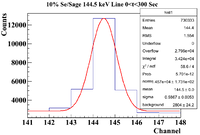 |
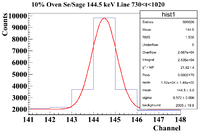 |
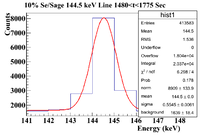 |
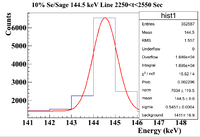 |
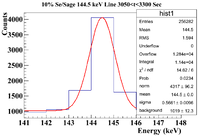 |
200px |
| Signal in Thin Window | 3.424 185.04 | 2.535 159.22 | 2.037 142.72 | 1.695 130.19 | 1.14 106.77 | |
| Integrated Background | 1.9628 167.4 | 1.4035 139.3 | 1.1473 128.80 | 9877 118.3 | 7133 86.1 | |
| Signal - Background | 1.4612 249.52 | 1.1315 211.55 | 8897 192.24 | 7073 175.91 | 4267 137.16 | |
| Runtime (s) | 300 | 290 | 295 | 300 | 250 | 275 |
| Rate (Hz) | 48.71 0.83 | 39.02 0.73 | 30.16 0.65 | 23.58 0.59 | 17.07 0.55 | |
| Integral Decay Correction (Hz) | ||||||
| Dead Time (%) | ||||||
| Dead Time Corrected Signal (Hz) |
